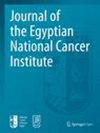Developing an efficient method for melanoma detection using CNN techniques
IF 2.1
Q3 ONCOLOGY
Journal of the Egyptian National Cancer Institute
Pub Date : 2024-02-26
DOI:10.1186/s43046-024-00210-w
引用次数: 0
Abstract
More and more genetic and metabolic abnormalities are now known to cause cancer, which is typically deadly. Any bodily part may become infected by cancerous cells, which can be fatal. Skin cancer is one of the most prevalent types of cancer, and its prevalence is rising across the globe. Squamous and basal cell carcinomas, as well as melanoma, which is clinically aggressive and causes the majority of deaths, are the primary subtypes of skin cancer. Screening for skin cancer is therefore essential. The best way to quickly and precisely detect skin cancer is by using deep learning techniques. In this research deep learning techniques like MobileNetv2 and Dense net will be used for detecting or identifying two main kinds of tumors malignant and benign. For this research HAM10000 dataset is considered. This dataset consists of 10,000 skin lesion images and the disease comprises nonmelanocytic and melanocytic tumors. These two techniques can be used for detecting the malignant and benign. All these methods are compared and then a result can be inferred from their performance. After the model evaluation, the accuracy for the MobileNetV2 was 85% and customized CNN was 95%. A web application has been developed with the Python framework that provides a graphical user interface with the best-trained model. The graphical user interface allows the user to enter the patient details and upload the lesion image. The image will be classified with the appropriate trained model which can predict whether the uploaded image is cancerous or non-cancerous. This web application also displays the percentage of cancer affected. As per the comparisons between the two techniques customized CNN gives higher accuracy for the detection of melanoma.利用 CNN 技术开发高效的黑色素瘤检测方法
现在已知越来越多的基因和代谢异常会导致癌症,而癌症通常是致命的。身体的任何部位都可能受到癌细胞的感染,从而导致死亡。皮肤癌是最常见的癌症类型之一,其发病率在全球呈上升趋势。鳞状细胞癌、基底细胞癌和黑色素瘤是皮肤癌的主要亚型,黑色素瘤在临床上具有侵袭性,导致大多数人死亡。因此,皮肤癌筛查至关重要。快速、精确地检测皮肤癌的最佳方法是使用深度学习技术。在这项研究中,MobileNetv2 和 Dense net 等深度学习技术将用于检测或识别恶性和良性两大类肿瘤。本研究考虑使用 HAM10000 数据集。该数据集由 10,000 张皮肤病变图像组成,疾病包括非黑色素细胞肿瘤和黑色素细胞肿瘤。这两种技术可用于检测恶性肿瘤和良性肿瘤。对所有这些方法进行比较后,可以从它们的性能中推断出结果。经过模型评估,MobileNetV2 的准确率为 85%,定制 CNN 的准确率为 95%。使用 Python 框架开发的网络应用程序提供了一个图形用户界面,其中包含最佳训练模型。图形用户界面允许用户输入患者详细信息并上传病变图像。图像将由经过适当训练的模型进行分类,该模型可预测上传的图像是癌变还是非癌变。该网络应用程序还能显示癌症发病率。根据两种技术的比较,定制的 CNN 检测黑色素瘤的准确率更高。
本文章由计算机程序翻译,如有差异,请以英文原文为准。
求助全文
约1分钟内获得全文
求助全文
来源期刊
CiteScore
3.50
自引率
0.00%
发文量
46
审稿时长
11 weeks
期刊介绍:
As the official publication of the National Cancer Institute, Cairo University, the Journal of the Egyptian National Cancer Institute (JENCI) is an open access peer-reviewed journal that publishes on the latest innovations in oncology and thereby, providing academics and clinicians a leading research platform. JENCI welcomes submissions pertaining to all fields of basic, applied and clinical cancer research. Main topics of interest include: local and systemic anticancer therapy (with specific interest on applied cancer research from developing countries); experimental oncology; early cancer detection; randomized trials (including negatives ones); and key emerging fields of personalized medicine, such as molecular pathology, bioinformatics, and biotechnologies.

 求助内容:
求助内容: 应助结果提醒方式:
应助结果提醒方式:


